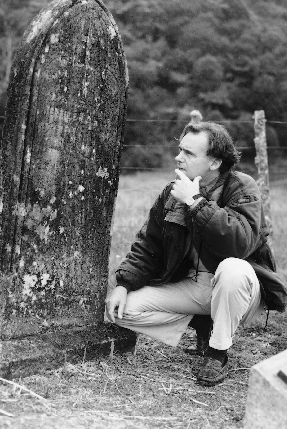Jade River: A History of the Mahurangi
Ronald H LockerFirst published 2001. Published online 2014–. This online edition is a work in progress…
Part 6 Settlers and services | The Point
Pages 252–253in printed edition
Mountain chief of Kennedys Hill

Kennedy’s Headstone in the Puhoi Cemetery: Here Paul Gittins, presenter of the television series Epitaph which dramatised events in Kennedy’s life, deciphers the inscription which reads ‘Of your charity pray for the repose of the soul of Terence Kennedy, native of Ireland, late of Mahurangi. Died 14th Sept. 1891. Aged 67 years. R.I.P.’ Before he died, Kennedy vowed to bequeath to God all his property if Bridget Daniel’s disappearance was explained. It was willed to the Sisters of Mercy, Ponsonby. image Rodney Times
There is a bold hill by the McElroy boundary, to which hangs another interesting Irish biography: Kennedys Hill.
Terence Kennedy was born of a poor family in County Clare in west Ireland. He was snatched early from the grave when a winter storm in 1824 razed his home, the infant and his mother were saved. At 18 he saw his parents evicted, and forced to eke out a living as fisherfolk.
Terence and his brother persuaded a captain to let them work their passages to the United States, but took up his further offer to take them on to New South Wales, where the captain’s brother would give them work on his run, 300 miles from Sydney. In 1844, Terence arrived in time to attend the grazier’s funeral. He became a shearer and drifted west to Kalgoorlie. After further adventures he came eventually to New Zealand, and took up a hundred acres on his hill in 1855. When he had cleared and grassed enough, he bought a big chestnut horse.
One day the isolated inhabitants of Pūhoi were startled by a man on a chestnut charger cantering into their village, said to have been the first horse to have done so. Terence had heard of this Catholic community, and being devout, wished to know when Mass was said. He was cordially received and became an esteemed addition to the flock.
Kennedy continued to live out his lonely life on the hill, cutting posts and firewood, and dragging them laboriously down to the Pukapuka for the scows to take away. But a blow was to fall on this quiet existence. The seven-year-old daughter of Daniel Sullivan was sent to borrow some flour, but never returned. After three days of searching, an inquest was held, in which Terence was charged. In spite of a unanimous jury verdict of ‘not guilty’ and ‘above suspicion’, folks other than his Pūhoi friends pointed the finger. (There had been blood on his clothes from slaughtering a cow). So he felt he lived under a cloud.
Four years later, a child’s skull and identifying clothes buttons were found three miles into the bush. She had been a simple child, and becoming lost, had wandered deeper into trouble. The absolution did little for Terence. Six months later he was suddenly taken ill at Henry Mason’s house and died there on 14 September 1891, aged 67. Everyone for miles turned out to his funeral at Pūhoi.
